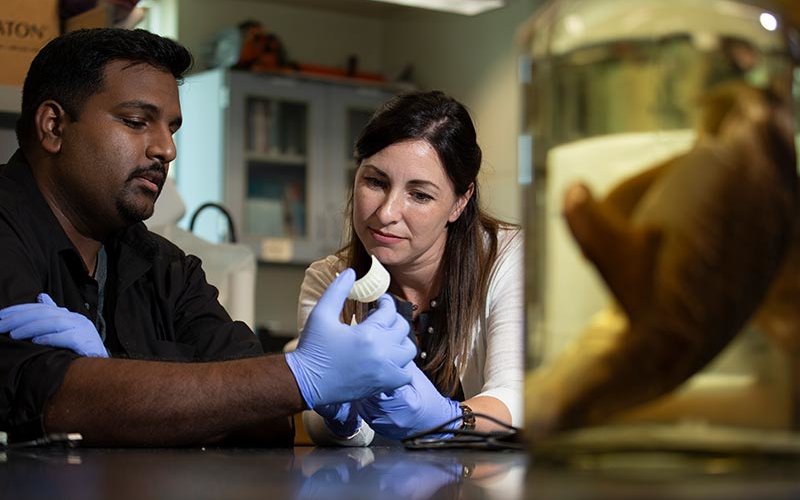
With wingspans of over 20 feet, manta rays are charismatic giants of the sea. Yet this enormous fish, which can weigh thousands of pounds, doesn’t chase down and bite into prey.
Instead, mantas comb the sea for smaller prey and capture huge amounts of tiny plankton, much smaller than the tip of a sharp pencil, using their gill rakers to filter food. Mantas may also filter small fish and crustaceans as part of their diet.
Cal State Fullerton biology graduate student Raj Divi and his faculty research adviser Misty Paig-Tran delved into a study to find out more about how this marine animal’s filtration system works.
Their research, published today, Sept. 26, in the peer-reviewed scientific journal Science Advances, found that manta ray filters can filter large volumes of particles from the water quickly — and surprisingly, without clogging. The manta ray’s unique mechanism for filtering particles may hold answers to better filtration systems.
“Studying how manta rays filter vast quantities of particle-filled water without clogging means that we may be able to design a filter to filter water in remote areas more cheaply, which could lead to fewer infectious diseases, or filter out microplastics from the ocean more efficiently using the same mechanisms,” Divi said.
Divi is lead author of the research paper titled “Manta Rays Feed Using Ricochet Separation, a Novel Non-Clogging Filtration Mechanism.” Paig-Tran, CSUF assistant professor of biological science, and James Strother, assistant professor of integrative biology at Oregon State University, are co-authors.
It was assumed that manta rays use a filter that functions kind of like a pasta colander, where particles remain while water drains out, Paig-Tran pointed out. But their study shows that this idea is not even close to how manta rays filter food from the water.
“Our study results show that manta rays do something really tricky. They create what we have termed a ‘ricochet filter’ to separate food from water,” added Paig-Tran, who has studied mantas for more than 10 years. “Particles enter into the mouth, then ricochet off the filter surface and back toward the esophagus, while water takes a different path and exits out the gill slits. It is very sophisticated — and cool.
“This is huge from an engineering perspective,” continued Paig-Tran, who studies comparative biomechanics, or the blending of engineering and biology to explore how organisms interact with the environment.
Additionally, these fishes can target particles much smaller than the pores in their filters, noted Divi, a first-time author.
Strother was instrumental in conducting computational models that confirmed the fluid forces behind the mechanism of filtration being used by mantas, which the researchers then termed “ricochet separation.”
Liquid filtration is an ubiquitous process found in industrial and biological systems, Paig-Tran explained.
“Although implementations vary widely, almost all filtration systems are based on a couple of fundamental separation mechanisms, such as sieve, cross-flow, hydrosol and cyclonic separation. Manta rays, on the other hand, have a highly specialized filter-feeding apparatus that does not resemble these filtration systems,” she added.
Divi, who holds a bachelor’s degree in bioengineering, became interested in the project so he could help solve practical human problems by linking his interests in both marine biology and engineering.
For his thesis research, Divi designed lab experiments to simulate the physical conditions of manta rays’ mouths and gill rakers during a feeding event. He also developed computer-aided design models of the filters. He then used a 3D printer to create generalized physical models of the filters.
“I designed and built a custom flow system that was cheap enough to build with equipment from the hardware store to simulate the flow conditions during a feeding event,” added Divi, who is on track to graduate in January.